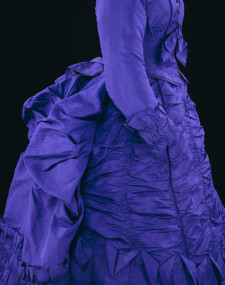Chemical Dyes?
- Patty Davis
- Apr 7, 2019
- 2 min read
The Color Purple….
Some of the earliest examples of the color purple have been found in early Roman settlements. The ancient Romans called the color Tyrian purple. It was the color of royalty and a designator of status. The dye was created by crushing thousands of marine snails and boiling them in a giant vat for an extended amount of time. Not many dye producers were interested in producing the color as it was extremely labor intensive, the raw materials were difficult to source and the finished product absolutely reeked. It was also very labor intensive and tricky to remove the unpleasant smell from the dyed fabric but preserve the lovely purple color. No one but royalty or those with status could afford the finished product.
As time went on, many other plant-based products produced different shades of purple, but it was difficult to keep the color from fading.
Around about the 1850’s a happy accident occurred that turned out to be a revolutionary to the types of dye pigments available to the public. The very first of those pigments was the color purple.
The story goes….An English chemist named William Perkin was working on a replacement for quinine. At the time, quinine was used as a cure for malaria. Quinine was rather expensive; consequently, the search was on for a more economical replacement.
After repeated failures, William had produced nothing more than a sticky black mess. The sticky black mess needed to be cleaned away to try the next version of his quinine alternative. He used alcohol to cut the stickiness. It turned out, the sticky mess mixed with his cleaning medium – alcohol, produced a beautiful deep purple liquid. William further thought it would make a beautiful pigment for papers and textiles. Consequently, Perkins Purple or Mauvine was discovered.
Perkins purple or Mauvine is considered the first of the chemical or aniline-based dyes. Even though the new dyes were stable and produced all manner of bright colors, all was not well. As time went on, a phenomenon known as Mauvine measles started afflicting those who wore the newly fashionable Mauvine color. When the fabric was not properly rinsed, chemicals leached into the wearer’s skin, causing mild to severe irritation. Mauvine measles was also seen to a greater extent in the factories that manufactured the pigment. No protection was worn while working with the chemicals and workers were regularly injured and even died as a result of chemical poisoning.
Just as a side note, Perkins was aware of how dangerous the chemicals were to handle. He did use protective gear. He also warned the manufacturers of the pigment of how hazardous the chemicals were to work with, but to no avail. Unfortunately, the injuries attributed to the manufacture of Mauvine dye also became among the first directly attributable cases of chemical health hazards in the workplace.





























Comments